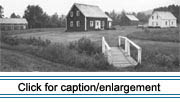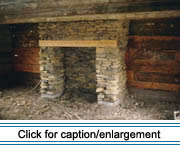|
This site, located in Keegan, a village a few miles west of Van Buren,
Maine, opened to the public in February 1976 as an American Bicentennial
project. It is owned and operated by the local volunteer historical society,
Notre HÈritage Vivant/Our Living Heritage. On the National Register nomination
form the site is described as a "multiple resource site" consisting of
seven buildings that form a "folk museum complex." Today it comprises
over a dozen buildings that have been moved to the Acadian Village or
built at the site. A number of these dwellings are significant in terms
of their distinct Maine Acadian construction.
 The
Levasseur-Ouellette House (built in Cyr Plantation, Maine, 1859) and the
Morneault House are typical of homes built during the mid-19th-century
by financially successful Maine Acadians. In form they are characteristic
of the "Georgian massing" style popular on both sides of the North Atlantic
by the early 19th century. The walls of both these one-and-a-half-story
dwellings are built of square-hewn logs (piËce sur piËce) covered
by clapboard siding. The
Levasseur-Ouellette House (built in Cyr Plantation, Maine, 1859) and the
Morneault House are typical of homes built during the mid-19th-century
by financially successful Maine Acadians. In form they are characteristic
of the "Georgian massing" style popular on both sides of the North Atlantic
by the early 19th century. The walls of both these one-and-a-half-story
dwellings are built of square-hewn logs (piËce sur piËce) covered
by clapboard siding.
 The
Morneault House is believed to have been built in 1857 by Charles Morneault
(Michaud 1974), a French-Canadian immigrant, on River Lot 197 in Grand
Isle, Maine. He settled in the Upper St. John Valley in 1856, and the
next year married Flavie Thibodeau. Morneault purchased Lot 197 in Township
18, Range 3 on November 3, 1857. He received the 433-acre parcel from
Jean Baptiste Souci, age 74, and Rose Thibodeau Souci, age 55, for $240
and a deed of maintenance. A merchant trader, Morneault provided space
for a post office in his home when members of his family served as postmaster.
Mrs. Normande BeauprÈ, a Morneault descendant, donated the house to Notre
HÈritage Vivant/Our Living Heritage in 1973, and it was subsequently moved
to the Acadian Village. The
Morneault House is believed to have been built in 1857 by Charles Morneault
(Michaud 1974), a French-Canadian immigrant, on River Lot 197 in Grand
Isle, Maine. He settled in the Upper St. John Valley in 1856, and the
next year married Flavie Thibodeau. Morneault purchased Lot 197 in Township
18, Range 3 on November 3, 1857. He received the 433-acre parcel from
Jean Baptiste Souci, age 74, and Rose Thibodeau Souci, age 55, for $240
and a deed of maintenance. A merchant trader, Morneault provided space
for a post office in his home when members of his family served as postmaster.
Mrs. Normande BeauprÈ, a Morneault descendant, donated the house to Notre
HÈritage Vivant/Our Living Heritage in 1973, and it was subsequently moved
to the Acadian Village.
|
 |
 |
 The Roy House, a log structure moved to the Village from a location near
Hamlin, Maine, is another example of 19th-century Maine Acadian house
construction. Its hewn log walls (piËce sur piËce) have been corner-joined
with trunnels in the "stacked and pegged" style also seen at Maison HÈritage
(see next section on Maison HÈritage). It is a form that has apparently
never been documented in the field. Although the Roy House was damaged
considerably during disassembly and reconstruction, it provides an opportunity
to examine this method of wall construction.
The Roy House, a log structure moved to the Village from a location near
Hamlin, Maine, is another example of 19th-century Maine Acadian house
construction. Its hewn log walls (piËce sur piËce) have been corner-joined
with trunnels in the "stacked and pegged" style also seen at Maison HÈritage
(see next section on Maison HÈritage). It is a form that has apparently
never been documented in the field. Although the Roy House was damaged
considerably during disassembly and reconstruction, it provides an opportunity
to examine this method of wall construction.
Two other 19th-century structures in the Acadian Village collection include
the Hammond-LaPlante Building, a workerís quarters from the William Hammond
farm in Hamlin Plantation, Maine; and a Maine Acadian barn (grange
acadienne) from the Hamlin area. The following are also located at
the museum: the Willie Sirois House, the Morin House, the Saint Amand
School, a blacksmith shop, a shoe shop, a barber shop and general store,
and a railroad car house. For the most part, these are interpretations
of razed historic structures. All of the structures house a large quantity
and variety of artifacts.
Apart from its primary museum functions, the Village is an important
staging ground for local cultural events. For example, during the 1991
Festival de La Grande RiviËre, it hosted "Acadian Day," "Multicultural
Day," and "Native American Day" celebrations. Four modern buildings are
used for temporary art exhibits, a gift shop, a meeting hall, and a chapel.
|
|

